Every now and then something truly expeditious occurs in technology or science (e.g., the speed forward of driverless-car development in the aftermath of the 2004 “Debacle in the Desert“). But progress is generally maddeningly slow, at least when viewed from the perspective of our own lifespans. So when Transhumanists promise a-mortality in two decades or people smart enough to know better argue that Moore’s Law will magically make everything just great by 2030, feel free to look askance.
Demonstrating this point: Sarah Zhang of Gizmodo scooped up an issue of Scientific American from a decade ago and measured the accuracy of the predictions on everything from stem cells to solar cells. It was not pretty. An excerpt:
I recently dig up the 2005 December issue of Scientific American and went entry by entry through the Scientific American 50, a list of the most important trends in science that year. I chose 2005 because 10 years seemed recent enough for continuity between scientific questions then and now but also long enough ago for actual progress. More importantly, I chose Scientific American because the magazine publishes sober assessments of science, often by scientists themselves. (Read: It can be a little boring, but it’s generally accurate.) But I also trusted it not to pick obviously frivolous and clickbaity things.
Number one on the list was a stem cell breakthrough that turned out to be one of the biggest cases of scientific fraud ever. (To be fair, it fooled everyone.) But the list held other unfulfilled promises, too: companies now defunct, an FBI raid, and many, many technologies simply still on the verge of finally making it a decade later. By my count, only two of its 16 medical discoveries of 2005 have resulted in a drug or hospital procedures so far. The rosy future is not yet here.
Science is not a linear march forward, as headlines seem to imply. Science is a long slow slog, and often a twisty one at that.•
Tags: Sarah Zhang

